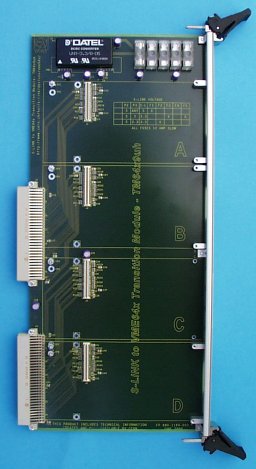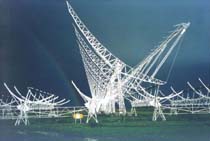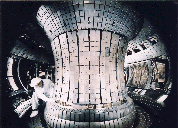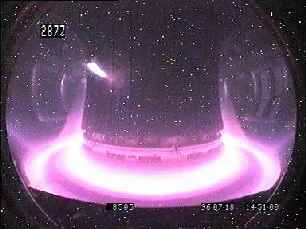

S-LINK News 2000
 VME64x
transition module
VME64x
transition module
22 December 2000. With the S2VME64x
transition module it is possible to have up to four S-LINK input on
the back of an VME64 externsions crate. This passive module routes all
S-LINK signals to the 5-row connectors on P2 and P3. This board has been
in use by the Liquid Argon detector of ATLAS since September 2000.
A new transition module is being designed that has small S-LINK buffers
on board, an Altera that can reformat and regroup the data coming from
four S-LINKs before it being sent to the P2 connector. This active transition
module is called the TM4plus1 as it has also an ODIN Link Source Card integrated
on the board. The TM4plus1, of which
prototypes will be available in June 2001, will allow the ATLAS Tilecal
detector to use the LArg Read-out Driver.
COMPASS buys 48 ODIN links
21 December 2000. The COMPASS experiment will base their readout
on S-LINK. In the year 2000 the experiment had already bought almost 40
FCS-LINK2
links and just before the end of the year 2000, another 48 ODIN
type links (thirty 128 MB/s and eighteen 160 MB/s versions) have been ordered.
The COMPASS
Frontend Readout Driver and Buffer Module (CATCH) that transmits the
data is designed by the University of Freiburg, while the Spill
Buffer that received the data on a PCI bus is designed by the Technical
University of München.
ATLAS ROD data format VHDL code
30 August 2000. Christoph Schwick has made available VHDL hardware
design code that can be used by ATLAS ROD designers.
The AtlasRODFormatter
is a VHDL-entity that formats data according to the ATLAS ROD - format
proposed in "The event format in the ATLAS DAQ/EF prototype-1" (Atlas
Daq note 50: ATL-DAQ-98-129). Data is formatted in order to be sent
via an S-LINK. He made it available as it can be of use for other developers
who have to implement a ROD on their cards.
The AtlasRODFormatter has been developed for the ALTERA FLEX 10K series.
It is used in the MIROD which is the Processor interfacing the LVL1 trigger
system with LVL2 and the Data Aquisition. The MIROD is part of the MUCTPI
(MUon to CTP Interface).
Another Linux driver
 |
14 July 2000. Jan Evert van Grootheest of the
company Control Application Engineering (CAE) has written for NIKHEF a
fully interrupt driven driver called SLD for the SSPCI interface
for generic Linux kernels. It has a zero-copy architecture and does
not use the normal read system call to retrieve data. The bigphysarea patch
is not required and the driver supports up to four interfaces in one PC.
The
driver has been released under the GPL. Already since 1997 Linux
drivers for S-LINK do exist. |
The world's largest CCD camera will be read out with S-LINK
23 June 2000. At the SPIE's "Astronomical Telescopes and Instrumentation
2000" conference the DAQ system of the Megacam
astronomical camera has been presented. Megacam is a wide-field imaging
camera being designed for the prime focus of the 3.6m Canada-France-Hawaii
Telescope, which will start observations in 2001. Each exposure will produce
about 770 MB of data; the mosaic will be read out in about 20 seconds which
means that Megacam will produce approximately 100 images (science fields
and calibration) per night, ie 77 GB of data each night or about 1 TB of
data for an average observing run. All imaging data will be send over four
S-LINKs.
One can read in the article "The
40 CCDs of the MegaCam wide-field camera: design and first tests of the
front-end electronics." of Jean de Kat et al:
Contrary to usual CCD Controllers, no complex boards have been
developped to transfer pixel data on optical fibers to the outside. We
use the SLink, developped in CERN (European Organisation for Nuclear Research);
it is a commercial optical link composed of two CMC cards. The SLink emitter
is easy to implement in a custom Controller since it is seen only as a
32bits synchronous Fifo. SLink can transfer continuous data flow at speed
of 100MB/s. In MegaCam, it is in fact limited to 80MB/s by SHARC 21060
link ports (note that is no more true with the next SHARC 21160 device).
The SLink receiver is directly PCI compatible, thus can be inserted
in many powerful computers. That makes the Controller output 'standard'
and not tied to a particular acquisition buffer. A VxWorks software driver
has been written for MegaCam. It consists essentially to initialize the
SLink and the DMA in the receiver side at each end of packet. The data
are transfered in 1074 pixels packets without use of the available control
words. The 4 slow rate return lines are not used, since a second link is
present for slow control.
The article concludes:
Thanks to high integration, the MegaCam CCD Controller found
its place very close to the detectors without any conflict with other parts
of the camera (cryogenic pulse tube, filter juke box, shutter, etc...).
It will not put much strain on weight, dimension and dissipation budgets
too. It will be at the same time the biggest CCD Controller of the world
and one of the most simple.
We are glad that the S-LINK has been able to contribute to this simple
design.
Want to know how a link design goes?
15 June 2000. Erik Brandin from KTH
Stockholm, was one of the three designers of the ODIN
S-LINK implementation. He spent nine months at CERN to design and debug
the link cards. After that he wrote his Masters Thesis which describes
the LHC accelerator, the ATLAS experiment, the place of S-LINK in ATLAS
and the design process of the ODIN S-LINK. If you're interested in the
details of a link design, his thesis Development
of a prototype Read-out link for the ATLAS Experiment (2.4 MB pdf)
will give you some insight.
You'll find out that there are many issues in designing a link. Each
time you need to use another type of serializer, you would have to redesign
major parts, such as error detection, data mapping and especially the reset
protocol. Fortunately when you use a ready-made link such as the ODIN,
you will not have to worry about those things as all S-LINK cards are compatible;
you just can buy the latest link version, which which at least up to 2001
will be the ODIN in either the 128 MB/s or 160 MB/s flavor.
Erik's stay at CERN was funded by TTA Technotransfer
AB / NFR.
Looking for Pulsars
 |
9 May 2000. The Osservatorio Astronomico di Bologna in Italy is
building a Pulsar observation
system. This system will be used at the italian 32 meter dish in Medicina
to observe Pulsar radiosources. Long term timing observations of pulsar
give information about the interior structure of neutron stars and is useful
in the understanding of the evolution of neutron stars. In timing observations,
the radiofrequency signal needs to be sampled in the time and frequency
domain, in order to dedisperse and detect the radio pulses.
The system uses S-LINK to read the data that is digitised at a maximum
frequency of 100 KHz into a PC with the Linux operating system. |
 |
Atlas TileCal takes testbeam data with commercial ROD and ROB
9 May 2000. The Atlas TileCal
detector has taken testbeam data with a system in which the Read-out
Driver (ROD) and the Read-out Buffer (ROB) consist all of commercially
available equipment. Both the front-end links from the detector to the
ROD and the ROD to ROB links are using S-LINK technology. Note that currently
used link is not radiation tolerant and that it is up to the people responsible
for the TileCal detector to design S-LINK boards that can withstand the
high radiation levels that will be around in the LHC environment.
S-LINK Pool for CERN
13 March 2000. The S-LINK team has set up an ordering service
for S-LINK equipment.To reduce delivery times, we also have a small stock
of most of the items. This service is available only to users in High-Energy
Physics institutes working with CERN. If you need any equipment, you may
contact directly Patrick
Donnat, Erik van
der Bij or Robert
McLaren. We prefer you to buy it, in which case we will do the ordering
and other handling for you. In case you need the equipment only for a short
period of time (less than 3 months), you may rent the equipment. Note that
currently the S-LINK Pool is not part of the CERN
Electronics Pool.
The list of devices that are in the S-LINK
Pool can be consulted online.
Nuclear fusion device uses S-LINK in DAQ system
 4
January 2000. On 21 December 1999, the ASDEX
upgrade nuclear fusion device started making regular plasma measurements
with the new reflectometry system - using an S-Link
based data acquisition system.
4
January 2000. On 21 December 1999, the ASDEX
upgrade nuclear fusion device started making regular plasma measurements
with the new reflectometry system - using an S-Link
based data acquisition system.
The purpose of this phase-run-away mirowave reflectometer is to measure
the rotation of turbulent structures in the plasma. This is achieved by
transmitting a microwave signal towards the plasma in an oblique direction,
which is reflected in the plasma and detected with a receiving antenna.
The rotation speed can be inferred from the Doppler shift of the received
microwave signal. This frequency shift appears as a running phase, hence
the name "Phase-run-away" diagnostics.
 Short data sheet:
Short data sheet:
-
A heterodyne reflectometer at 50-75 GHz RF frequency,
-
80 MHz IF frequency and phase/quadrature detection.
-
FCSlink, operated with the dedicated "FEMCTRL" FEMB control board,
-
2 Burr Brown ADS801U (12-bit 25 MHz pipelined ADC)
-
Sample rate 20 MHz, S-Link clock rate 40 MHz,
-
constant data rate = 80 MBytes/s
-
Receiving end is a Pentium II 350 MHz PC (512 MByte RAM)
-
running Linux (SuSE 5.3, kernel 2.0.36 with bigphysarea patch)
-
for each plasma experiment:
-
400 MByte (exactly 410'000'000 byte) DMA buffer
-
filled in ~5 Seconds
-
stored to IDE disk in ~1 minute.
The ASDEX Upgrade tokamak
(Axially Symmetric Divertor EXperiment) went into operation at Garching
in 1990. This fusion device, Germany's largest at present, is for investigating
crucial problems in fusion research under reactor-like conditions. For
this purpose essential plasma properties, particularly the plasma density
and the wall load, have been adapted to the conditions that will be present
in a future fusion reactor.
Old S-LINK News
CERN - High Speed Interconnect
- S-LINK
Erik van der Bij - 7 June 2001


 VME64x
transition module
VME64x
transition module


 4
January 2000. On 21 December 1999, the ASDEX
upgrade nuclear fusion device started making regular plasma measurements
with the new reflectometry system - using an S-Link
based data acquisition system.
4
January 2000. On 21 December 1999, the ASDEX
upgrade nuclear fusion device started making regular plasma measurements
with the new reflectometry system - using an S-Link
based data acquisition system.
 Short data sheet:
Short data sheet: